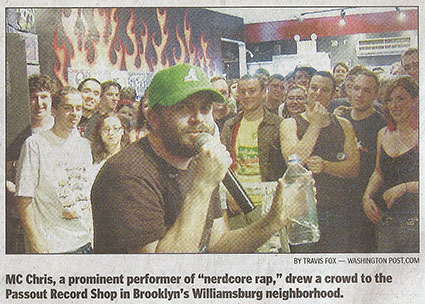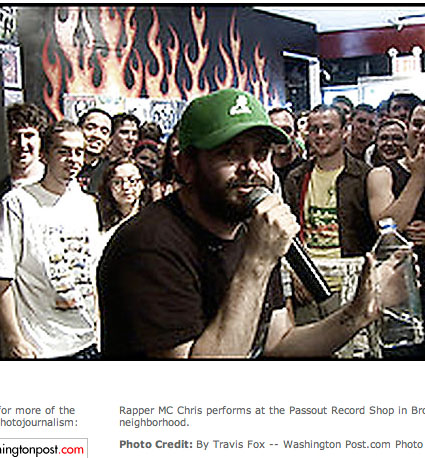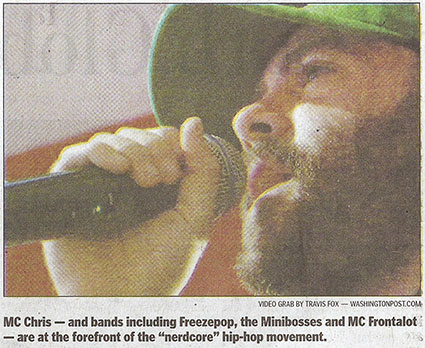NFL Vests - What's Your Backside REALLY Worth?
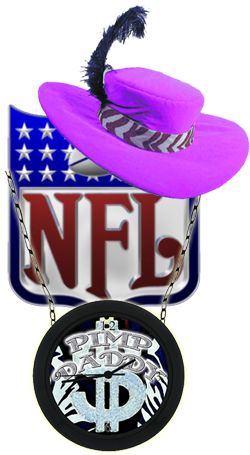 I recently spent some time doing some research on this vests issue to post over at Sportsshooter here, but I thought I'd tweak it a bit for you to read here, as well. So, to those who are not concerned because "the logo is small/on-the-front", I say to you that they will incrementally take your "ad space".
I recently spent some time doing some research on this vests issue to post over at Sportsshooter here, but I thought I'd tweak it a bit for you to read here, as well. So, to those who are not concerned because "the logo is small/on-the-front", I say to you that they will incrementally take your "ad space".
It's one thing to require a bright vest for security purposes, but, in reality, having been on the field at the All-Star game and World Series, there are so many non-vested people, that policing that is really a joke. PDN has an article where they show the actual vest, so check that out too.
You need only look so far as the FunPix section of the Sportsshooter website:
What it should/could be: http://www.sportsshooter.com/funpix_view.html?id=6213 and what is was a few months ago, at Pimlico, and WILL BE at all other venues soon: http://www.sportsshooter.com/funpix_view.html?id=6725. Note there, that that NIKON logo is atleast 3 inches tall and spans the entire bib!. Nice how this funpix shows both the front and back.
Would you like to see how your backside will be used by the NFL - a la Preakness style -- soon?
Here's a nice Getty Images shot showing the NFL logo - imagine that being YOU and the NFL logo saying something else, and here's another. (Note, if you've never been to the Getty site, choose your country/language, and you'll get there. If not, search for image # 73204093 or #73203983 for the photos).
When someone sees that bright BLANK space down on the field, they see dollar-signs - as ad revenue.
Consider this:
The Bedford Group has a Sports Marketing white paper here Which posits:
Q: What is the cost of the stadium billboard (per 1,000 potential viewers) vs. that of similar outdoor boards? What's the premium for being in the stadium with a captive audience?NOW, what is your backside worth? IF ALL of the photographers are wearing a corporate logo in their backside, which is being seen by fans time and time again - DURING the game on tv AND from the stands by 60k+, it's easy to figure out.
A: Note, it is generally accepted that a sign in a sports venue can be more valuable than a billboard because: (1) The audience is fixed for several hours at a time vs. simply passing by in a car (2) the sign can be shown on television during matches, thus gaining a wider audience.
For televised games, what is the value of the Company logo (from the stadium sign) appearing occasionally during each broadcast? Take a guess and determine that, for example, it will get 30 seconds of airtime
during each broadcast game, then give the sign additional value (getting a 30 second TV spot free).
So, let's do some math:
Clear Channel has a rate calculator - available here.
Now, going through that calculator - SF Bay Area, 8-sheet poster, general market, they will charge a mid-range price of $40,000 for four weeks, or $10,000 a week, and this presupposes that the four week "circulation" is approximately 57,000 people. For this, an 8 sheet poster is 5'x11', or 55 square feet. Your back is approximately 18" x 18" of usable space, or 2.25 square feet. $10k at 55 sq ft equates to $182 per sq ft. For your backside, that'd be $409, per person, for one stadium with 50,000+.
Imagine this conversation:
"We credential 40 photographers per game, and all are fieldside, that's 40 times 2.25 sq ft per person, or 90 square feet. Clear Channel charges about $16,000 to reach 50,000 people or so at that size. You are reaching not just that audience, but our research, in reviewing broadcast tapes of games from the last 24 months, show that those blank-slate bibs appear for a combined total of 16 seconds a game - during the game, when fans are more likely to be paying attention. NFL division playoff games have a rate of $600,000 per 30-second spot. Since, in those ads, you are designing the presentation, it makes sense. In this case, we're showcasing your logo fieldside, but only for 16 seconds. To start things off, we'll cut the per-second cost that 16 seconds would be - $320,000 down to $160,000, for the one game. But you have to commit to an entire season."So, you're worth $409 as a static billboard, per game, and $4,000 as a portion of the tv ad (40 backsides at $160,000 per game), or, $4,409 - per game. Now, how many games are there?Source: Data360.org
Nice. A stringer makes $200 Work-for-hire from the wire service, who earns that back with just one image sale, and the team makes $4,000+ off your backside.
Please post your comments by clicking the link below. If you've got questions, please pose them in our Photo Business Forum Flickr Group Discussion Threads.
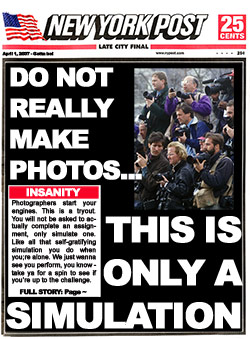 The race is on! Apparently, tryouts for the NY Post are underway this week.
The race is on! Apparently, tryouts for the NY Post are underway this week. 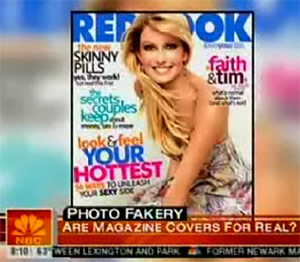 Back in January,
Back in January, 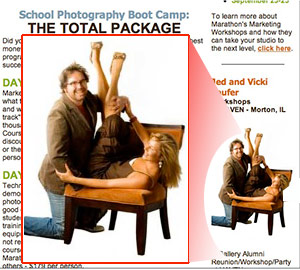 At the Kodak Professional's ProPass website,
At the Kodak Professional's ProPass website,  For awhile now, many of you have written in the comments, and to me privately, about just how "photojournalism is dead", or some variation thereof. In many cases, you're right. However, for those who set their own terms, specify what they are (and are not) willing to accept for any given assignment, and otherwise chart their own editorial course, work can be highly satisfying and lucrative.
For awhile now, many of you have written in the comments, and to me privately, about just how "photojournalism is dead", or some variation thereof. In many cases, you're right. However, for those who set their own terms, specify what they are (and are not) willing to accept for any given assignment, and otherwise chart their own editorial course, work can be highly satisfying and lucrative. 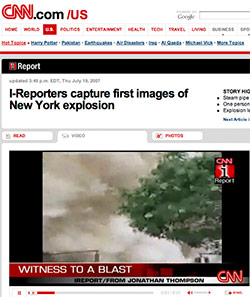 Within seconds to minutes of the explosion the local television channels were actively soliciting video tape, cell phone footage, still imagery and equivalents from the public for the expressed purpose of reportage. Websites, particularly gothamist.com featured “live coverage” employing un-credited “live” footage of the steam geyser. The publisher was on NPR this morning expounding with great clarity how she was effectively able to beat out the coverage of the New York network affiliates by using images freely sent to her. The images were and are more than adequate (take a look). The site paid zilch, zero, nada for the footage.
Within seconds to minutes of the explosion the local television channels were actively soliciting video tape, cell phone footage, still imagery and equivalents from the public for the expressed purpose of reportage. Websites, particularly gothamist.com featured “live coverage” employing un-credited “live” footage of the steam geyser. The publisher was on NPR this morning expounding with great clarity how she was effectively able to beat out the coverage of the New York network affiliates by using images freely sent to her. The images were and are more than adequate (take a look). The site paid zilch, zero, nada for the footage.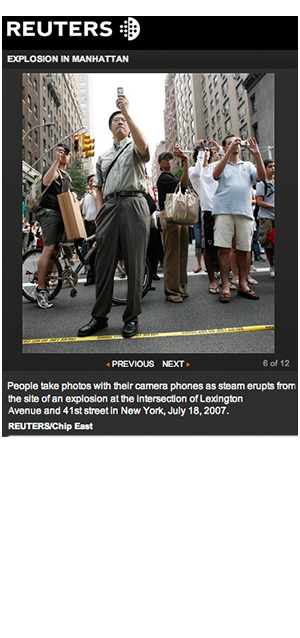 Those print photo credits which do appear may be misleading as one or more agencies no doubt purchased images from unsuspecting amateurs outright. This practice pre-dates the oldest reader of this post. We do note that of the nine photos which appear in the tabloid NY Post of Thursday, July 19, 2007, not a single one bears a NY Post photo credit nor indicates that the shooter has any staff affiliation with The Post.
Those print photo credits which do appear may be misleading as one or more agencies no doubt purchased images from unsuspecting amateurs outright. This practice pre-dates the oldest reader of this post. We do note that of the nine photos which appear in the tabloid NY Post of Thursday, July 19, 2007, not a single one bears a NY Post photo credit nor indicates that the shooter has any staff affiliation with The Post.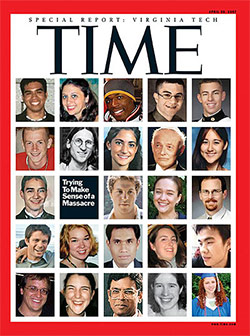 Client Adrienne DeArmas, working for Time Magazine on the Virginia Tech massacre story, was unable to procure/arrange for the creation of images that could compete with the Myspace and Facebook images of the students killed, their friends, families and teachers. The cover of TIME that week was a grid of said photos, with not one professionally shot image among them.
Client Adrienne DeArmas, working for Time Magazine on the Virginia Tech massacre story, was unable to procure/arrange for the creation of images that could compete with the Myspace and Facebook images of the students killed, their friends, families and teachers. The cover of TIME that week was a grid of said photos, with not one professionally shot image among them.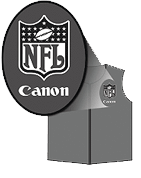 The article goes on to report "But some of the NFL's other actions have horrified Alex Marvez, president of the Pro Football Writers Association and a South Florida Sun-Sentinel reporter. He winces at the new rule requiring photographers to wear red vests with small Canon and Reebok logos. Mr. Marvez calls the idea of using working press members as advertising vehicles "really alarming." Neither company is paying a specific fee for the vests, but Canon Inc. is an official sponsor of the league (it pays a rights fee to be associated with the NFL) and Reebok International Ltd., owned by Adidas AG, is a league licensee (it makes merchandise with NFL logos, including jerseys, pants and photo vests)." (as shown above left).
The article goes on to report "But some of the NFL's other actions have horrified Alex Marvez, president of the Pro Football Writers Association and a South Florida Sun-Sentinel reporter. He winces at the new rule requiring photographers to wear red vests with small Canon and Reebok logos. Mr. Marvez calls the idea of using working press members as advertising vehicles "really alarming." Neither company is paying a specific fee for the vests, but Canon Inc. is an official sponsor of the league (it pays a rights fee to be associated with the NFL) and Reebok International Ltd., owned by Adidas AG, is a league licensee (it makes merchandise with NFL logos, including jerseys, pants and photo vests)." (as shown above left).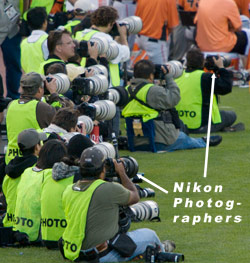 To the left is the sidelines at a recent MLB game that I made. Aside from seeing the horrible yellow, what I see is where sports marketing person could say, during the game when touring a potential sponsor - "See all those blank yellow vests down there. That blank space could be instead have your logo, we make them wear those....". Well, now, sections of the vest have sponsor logos. Soon, each vest could well look like a NASCAR car, with major and minor logos. I see atleast two photographers with Nikon gear, just on this side of the field.
To the left is the sidelines at a recent MLB game that I made. Aside from seeing the horrible yellow, what I see is where sports marketing person could say, during the game when touring a potential sponsor - "See all those blank yellow vests down there. That blank space could be instead have your logo, we make them wear those....". Well, now, sections of the vest have sponsor logos. Soon, each vest could well look like a NASCAR car, with major and minor logos. I see atleast two photographers with Nikon gear, just on this side of the field.